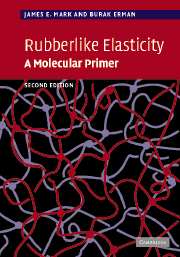Book contents
- Frontmatter
- Contents
- Preface to the first edition
- Preface to the second edition
- Part I Fundamentals
- Part II Additional topics
- 11 Networks prepared under unusual conditions
- 12 Strain-induced crystallization and ultimate properties
- 13 Multimodal networks
- 14 Birefringence and segmental orientation
- 15 Neutron scattering from networks
- 16 Liquid-crystalline elastomers
- 17 Bioelastomers
- 18 Filled elastomers
- 19 Current problems and new directions
- Appendix A Relationships between ν, ξ and Mc
- Appendix B Relationships between 〈r2〉, 〈(Δr)2〉, 〈r2〉0, and ϕ
- Appendix C Equations of state for miscellaneous deformations from the constrained junction theory
- Appendix D Thermodynamics of the relationship of stress to temperature
- Problems
- Answers to problems
- Some publications describing laboratory/classroom experiments or demonstrations
- References
- Index
14 - Birefringence and segmental orientation
from Part II - Additional topics
Published online by Cambridge University Press: 04 December 2009
- Frontmatter
- Contents
- Preface to the first edition
- Preface to the second edition
- Part I Fundamentals
- Part II Additional topics
- 11 Networks prepared under unusual conditions
- 12 Strain-induced crystallization and ultimate properties
- 13 Multimodal networks
- 14 Birefringence and segmental orientation
- 15 Neutron scattering from networks
- 16 Liquid-crystalline elastomers
- 17 Bioelastomers
- 18 Filled elastomers
- 19 Current problems and new directions
- Appendix A Relationships between ν, ξ and Mc
- Appendix B Relationships between 〈r2〉, 〈(Δr)2〉, 〈r2〉0, and ϕ
- Appendix C Equations of state for miscellaneous deformations from the constrained junction theory
- Appendix D Thermodynamics of the relationship of stress to temperature
- Problems
- Answers to problems
- Some publications describing laboratory/classroom experiments or demonstrations
- References
- Index
Summary
Introduction
The directions of chain segments are isotropically distributed in an undistorted network. Macroscopic distortion of the network, however, results in anisotropy at the microscopic level in that the distribution of segment orientations is no longer the same in all directions. The anisotropy resulting from macroscopic deformation is accompanied by optical anisotropy associated with these varying orientations of the polarizability tensors of the repeat units. Consequently the refractive indices of the network along different directions become unequal, and the network is said to be birefringent. The theory of birefringence of affine networks has been outlined by Treloar (Treloar, 1975). In this chapter, the derivation of birefringence will be given for both affine and phantom networks, followed by a more general discussion of the problem of segmental orientation and its experimental determination.
Birefringence of affine and phantom networks
First, we consider a single chain in the network whose ends are fixed at the origin and at the point (x, y, z) of a laboratory-fixed coordinate system 0xyz. The x-axis is chosen to lie along the direction of stretch of the network. The segments of the chain are assumed to experience all possible spatial configurations subject to the constancy of the end-to-end vector r. The polarizability tensor for the chain with a given configuration is obtained as the sum of the polarizability tensors of structural units comprising the chain (Volkenstein, 1963; Flory, 1969).
- Type
- Chapter
- Information
- Rubberlike ElasticityA Molecular Primer, pp. 149 - 158Publisher: Cambridge University PressPrint publication year: 2007



